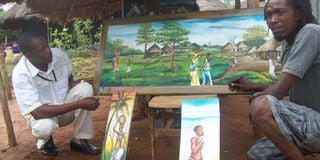Restoring Luo culture through art and craft

Thomas Opio and Timothy Ocen display some of their paintings of the Acholi Traditional home setting. The two are seeking to educate the youth in the area about their past. Photo by Cissy Makumbi.
What you need to know:
The twin brothers are using their skills to teach the youth about the past.
While their age-mates are troubled, looking for jobs, Timothy Ocen and Thomas Opio, the 33-year old twins, have found solace in art and craft, making pieces that depict the Luo culture.
When I meet them, Ocen, the director of AfriArt Gulu, is finishing a drawing on the nativity of Jesus Christ, on a two-metre piece of cloth, in a grass thatched hut which also acts as an office.
A qualified secondary school teacher of art, Ocen taught for only six months at Gulu Army Secondary school in 2005 before turning to start his own business.
When peace returned to the once war ravaged region, Opio who had studied brick laying at Lugogo Vocational Institute and later, Counselling and Guidance, joined his brother in 2010. Though Opio is not a qualified artist, he has learnt the skills from his brother.
“Art is inborn. Opio and I used to compete in art and when we started the business, it was just to supplement on what he already had. Our grandfather does pottery and we are following in his footsteps,” Ocen says.
Many of the youth in Gulu grew up in camps and were not able to see traditional homesteads, but through their art and craft, the twins are trying to educate their community.
Some of the paintings show the Acholi homestead, with animals tied, in the compound, a granary and the head of the family doing some domestic work with his wife and children.
They also have a painting of an African woman, half dressed to portray her beauty. However, the people in the area are yet to appreciate their work.
Mr Ocen says, “The region is still ignorant about paintings, and many just walk by them. But we are optimistic. With time, people will get to understand its beauty.”
Their largest market are the hotels and their customers include Chobe Safari Lodge, Paraa Safari Lodge, Palema Hotel, Golden Piece and Acholi Bar hotel They also supply restaurants, schools, churches and local crafts shops within town. Festive seasons like Easter, Christmas and New Year are the periods they sell many paintings, as well as in August when many tourists visit the region.
More than 70 pieces have been taken to the USA for exhibition. A painting on a two-metre piece of cloth goes for Shs250,000 and above depending on what is drawn. The smallest piece costs between Shs20,000 and Shs50,000. Sculptures on walls and compound designs go for Shs80,000 to Shs120,000.
Other items they make include earrings, bangles, necklaces and sign posts, with some of their the raw materials being, snail shells, paint and cow horns.
The hard work seems to be yielding results as Ocen says they earn profits of between Shs320,000 and Shs500,000 monthly.
Hurdles they meet
He, however, notes that the business is slow due to low appreciation in the region. The twins point that out as a reason to the limited market, besides, local leaders have been stopped from having paintings that depict the region’s turbulent times. Also, lack of enough capital and the expensive materials escalate the problem.
In 2011, there seemed a ray of hope and Ocen was very excited when the government in partnership with specific banks in the country made available a venture capital fund worth Shs25b for the youth. However, like many, he has not been able to obtain money from it, due to the strings attached.
The fund was to support and promote venture capital debt to finance viable projects proposed by the young entrepreneurs such as Ocen, as well as enable them benefit from associated mentoring services from the participating banks to help avert unemployment. Such [vocational] jobs, Ocen contends, can go a long way in easing pressure on government should the industry be given a conducive environment to thrive.
Ocen and Opio are also in the business of teaching people their craft. “We also teach women and youth how to make art pieces, beads, bangles and bracelets,” Ocen says.
They currently directly employ 12 people so far.
Ocen hopes to open an art gallery and a website to market their products and perhaps a school of art and design in the region so that people can appreciate and also compare the pre-colonial life and the present.




